Psio 201 exam Study guides, Class notes & Summaries
Looking for the best study guides, study notes and summaries about Psio 201 exam? On this page you'll find 29 study documents about Psio 201 exam.
Page 3 out of 29 results
Sort by
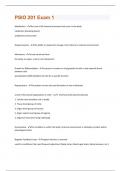
-
PSIO 201 Exam 1| 58 Questions and Answers(A+ Solution guide)
- Exam (elaborations) • 7 pages • 2023
- Available in package deal
-
- $3.99
- + learn more
Metabolism - the sum of all chemical processes that occur in the body catabolism (breaking down) anabolism (construction Responsiveness - the ability to respond to change in the internal or external environment Movement - at any structural level the body, an organ, a cell or cell component Growth an Differentiation - increase in number or size (growth) of cells or the material found between cells specialization (differentiation) of cells for a specific function Reproduction - formation ...
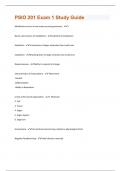
-
PSIO 201 Exam 1 Study Guide | 83 questions with complete solution graded A+
- Exam (elaborations) • 9 pages • 2023
- Available in package deal
-
- $3.49
- + learn more
Metabolism occurs in how many recurring processes - 2 Name each process of metabolism - Anabolism & Catabolism Anabolism - Construction of larger molecules from small ones Catabolism - Breaking down of large molecules into small ones Responsiveness - Ability to respond to change Characteristics of living systems - -Movement -Growth -Differentiation -Ability to Reproduce Levels of Structural organization - 1. Molecule 2. Cell 3. Tissue 4. Organ 5. Organ System 6. Organism Homeostas...
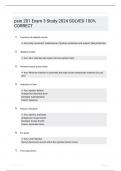
-
psio 201 Exam 3 Study 2024 SOLVED 100 CORRECT
- Exam (elaborations) • 9 pages • 2024
-
- $14.99
- + learn more
psio 201 Exam 3 Study 2024 SOLVED 100% CORRECT Functions of skeletal muscle skeletal muscle Reverse Muscle Action (RMA) abduction of arm flexion of forearm For joints First class levers Second class levers third class lever For all levers in the middle remember groups of muscles are covered by The entire muscle is covered by? A facicle is fasicle is covered by A muscle fiber is covered by Muscle cell/fiber size muscle development 3 units of muscle organization Muscle conductio...
PSIO 201--Exam 2-- University of Arizona Verified 100% Correct!!
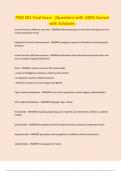
-
PSIO 201 Final Exam |Questions with 100% Correct with Solutions
- Exam (elaborations) • 20 pages • 2024
-
- $12.99
- + learn more
sensory function (afferent neurons) - ANSWER information goes to the brain and spinal cord via cranial and spinal nerves integrative function (interneurons) - ANSWER integrates sensory information by analyzing and storing it motor function (efferent neurons) - ANSWER information from the brain and spinal cord is sent out to muscles or glands (effectors) brain - ANSWER -control center of the human body -center of intelligence, behavior, memory and emotion -coordinates activity of skeletal...
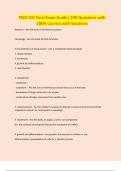
-
PSIO 201 Final Exam Guide| 209 Questions with 100% Correct with Solutions
- Exam (elaborations) • 20 pages • 2024
-
- $12.99
- + learn more
Anatomy - Ans the study of the body structures Physiology - Ans the study of body functions 5 characteristics of living system - Ans 1. metabolism (heat produce) 2. responsiveness 3. movement 4. growth and differentiation 5. reproduction

-
PSIO 201Exam 2 University of Arizona Questions Solutions
- Exam (elaborations) • 10 pages • 2024
-
- $12.49
- + learn more
PSIO 201--Exam 2-- University of Arizona - Questions & Solutions Bone Types Periosteum Endosteum Why is bone considered an organ? Osteogenic Cells Osteoblasts Osteocytes Osteoclasts Bone Modeling Bone Remodeling Cartilage Tissue Bone Tissue Collagen Minerals Rickets (Inorganic) Scurvy (Organic) Sponge Bone Organization Spongy Bone Location Spongy Bone Functions Compact Bone Organization Compact Bone Location Compact Bone Function Osteons Fontanels Epiphysis of Long Bones...
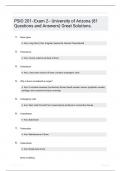
-
PSIO 201Exam 2 University of Arizona 81 Questions and Answers Great Solutions
- Exam (elaborations) • 9 pages • 2024
-
- $14.49
- + learn more
PSIO 201--Exam 2-- University of Arizona (81 Questions and Answers) Great Solutions. Bone Types Periosteum Endosteum Why is bone considered an organ? Osteogenic Cells Osteoblasts Osteocytes Osteoclasts Bone Modeling Bone Remodeling Cartilage Tissue Bone Tissue Collagen Minerals Rickets (Inorganic) Scurvy (Organic) Sponge Bone Organization Spongy Bone Location Spongy Bone Functions Compact Bone Organization Compact Bone Location Compact Bone Function Osteons Fontanels Epi...

-
PSIO 201Exam 2 University of Arizona QUESTIONS AND ANSWERS GRADED A
- Exam (elaborations) • 9 pages • 2024
-
- $12.49
- + learn more
PSIO 201--Exam 2-- University of Arizona QUESTIONS AND ANSWERS GRADED A+ Bone Types Periosteum Endosteum Why is bone considered an organ? Osteogenic Cells Osteoblasts Osteocytes Osteoclasts Bone Modeling Bone Remodeling Cartilage Tissue Bone Tissue Collagen Minerals Rickets (Inorganic) Scurvy (Organic) Sponge Bone Organization Spongy Bone Location Spongy Bone Functions Compact Bone Organization Compact Bone Location Compact Bone Function Osteons Fontanels Epiphysis of Lo...

Did you know that on average a seller on Stuvia earns $82 per month selling study resources? Hmm, hint, hint. Discover all about earning on Stuvia



